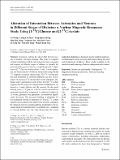| dc.contributor.author | Wang, Na | |
| dc.contributor.author | Zhao, Liang-Cai | |
| dc.contributor.author | Zheng, Yong-Quan | |
| dc.contributor.author | Dong, Min-Jian | |
| dc.contributor.author | Su, Yongchao | |
| dc.contributor.author | Chen, Wei-Jian | |
| dc.contributor.author | Hu, Zi-Long | |
| dc.contributor.author | Yang, Yun-Jun | |
| dc.contributor.author | Gao, Hong-Chang | |
| dc.date.accessioned | 2016-11-29T14:43:54Z | |
| dc.date.available | 2016-11-29T14:43:54Z | |
| dc.date.issued | 2014-07 | |
| dc.date.submitted | 2014-03 | |
| dc.identifier.issn | 0893-7648 | |
| dc.identifier.issn | 1559-1182 | |
| dc.identifier.uri | http://hdl.handle.net/1721.1/105454 | |
| dc.description.abstract | Increasing evidence has shown that the brain is a site of diabetic end-organ damage. This study investigates cerebral metabolism and the interactions between astrocytes and neurons at different stages of diabetes to identify the potential pathogenesis of diabetic encephalopathy. [1-[superscript 13]C]glucose or [2-[superscript 13]C]acetate is infused into 1- and 15-week diabetic rats, the brain extracts of which are analyzed by using [superscript 1]H and [superscript 13]C magnetic resonance spectroscopy. The [superscript 13]C-labeling pattern and enrichment of cerebral metabolites are also investigated. The increased [superscript 13]C incorporation in the glutamine, glutamate, and γ-aminobutyric acid carbons from [2-[supercript 13]C]acetate suggests that the astrocytic mitochondrial metabolism is enhanced in 1-week diabetic rats. By contrast, the decreased labeling from [1-[superscript 13]C]glucose reflected that the neuronal mitochondrial metabolism is impaired. As diabetes developed to 15 weeks, glutamine and glutamate concentrations significantly decreased. The increased labeling of glutamine C4 but unchanged labeling of glutamate C4 from [2-[superscript 13]C]acetate suggests decreased astrocyte supply to the neurons. In addition, the enhanced pyruvate recycling pathway manifested by the increased lactate C2 enrichment in 1-week diabetic rats is weakened in 15-week diabetic rats. Our study demonstrates the overall metabolism disturbances, changes in specific metabolic pathways, and interaction between astrocytes and neurons during the onset and development of diabetes. These results contribute to the mechanistic understanding of diabetes pathogenesis and evolution. | en_US |
| dc.description.sponsorship | National Natural Science Foundation (China) (Grant 21175099) | en_US |
| dc.description.sponsorship | Natural Science Foundation of Zhejiang Province (Grant LY14H090014) | en_US |
| dc.description.sponsorship | Zhejiang Provincial Program for the Cultivation of High-Level Innovative Health Talents | en_US |
| dc.description.sponsorship | Science and Technology Foundation of Wenzhou (Grant Y20100005) | en_US |
| dc.publisher | Springer US | en_US |
| dc.relation.isversionof | http://dx.doi.org/10.1007/s12035-014-8808-4 | en_US |
| dc.rights | Article is made available in accordance with the publisher's policy and may be subject to US copyright law. Please refer to the publisher's site for terms of use. | en_US |
| dc.source | Springer US | en_US |
| dc.title | Alteration of Interaction Between Astrocytes and Neurons in Different Stages of Diabetes: a Nuclear Magnetic Resonance Study Using [1-[superscript 13]C]Glucose and [2-[superscript 13]C]Acetate | en_US |
| dc.title.alternative | Alteration of Interaction Between Astrocytes and Neurons in Different Stages of Diabetes: a Nuclear Magnetic Resonance Study Using [1-13C]Glucose and [2-13C]Acetate | en_US |
| dc.type | Article | en_US |
| dc.identifier.citation | Wang, Na et al. “Alteration of Interaction Between Astrocytes and Neurons in Different Stages of Diabetes: A Nuclear Magnetic Resonance Study Using [1-[superscript 13]C]Glucose and [2-[superscript 13]C]Acetate.” Molecular Neurobiology 51.3 (2015): 843–852. | en_US |
| dc.contributor.department | Massachusetts Institute of Technology. Department of Chemistry | en_US |
| dc.contributor.department | Francis Bitter Magnet Laboratory (Massachusetts Institute of Technology) | en_US |
| dc.contributor.mitauthor | Su, Yongchao | |
| dc.relation.journal | Molecular Neurobiology | en_US |
| dc.eprint.version | Author's final manuscript | en_US |
| dc.type.uri | http://purl.org/eprint/type/JournalArticle | en_US |
| eprint.status | http://purl.org/eprint/status/PeerReviewed | en_US |
| dc.date.updated | 2016-08-18T15:45:55Z | |
| dc.language.rfc3066 | en | |
| dc.rights.holder | Springer Science+Business Media New York | |
| dspace.orderedauthors | Wang, Na; Zhao, Liang-Cai; Zheng, Yong-Quan; Dong, Min-Jian; Su, Yongchao; Chen, Wei-Jian; Hu, Zi-Long; Yang, Yun-Jun; Gao, Hong-Chang | en_US |
| dspace.embargo.terms | N | en |
| mit.license | PUBLISHER_POLICY | en_US |
